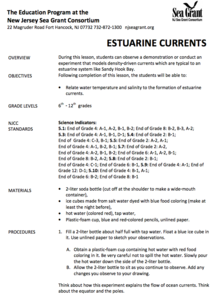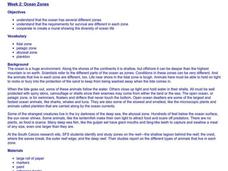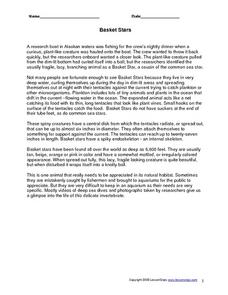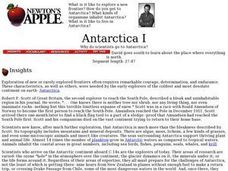Curated OER
Bermuda Reef Diorama
Students build a Bermuda coral reef to gain a better understanding of this ecosystem.
Curated OER
Great Lakes Ecology
Young scholars are able to use a secchi disk to measure the turbidity of water by determining the depth at which the sechi disk is no longer visible and using the data in a formula to quantify the results. They are able to use Vernier...
Curated OER
Ocean Voyage Scavenger Hunt
In this ocean voyage worksheet, students utilize the Internet to access one specific website to find the answers to five short answer questions about oceans.
Curated OER
Examining the Stages of Ecological Succession
In this ecological succession worksheet, students answer questions about the process of succession in four ponds given diagrams and descriptions.
Curated OER
Life Means Water Environment
Students investigate pH levels in bodies of water and experiment with acid/base reactions. In this water and pH lesson, students observe changes in pH levels of a sample solution and observe a Bronsted-Lowry reaction. Students...
Curated OER
Web of Life Game: Trout
Students explore the concept of food webs. In this food web lesson plan, students demonstarte the connection between species. Students use a ball of string show how the food web works, then have a class discussion.
Curated OER
Introduction to Sea Horses
Students identify different types of sea horses. In this sea horse research lesson, students learn associated vocabulary and listen as the teacher reads Elaine Landau's, Sea Horses A True Book. They visit assigned Internet sites to find...
Curated OER
Fearsome Creatures 1
In this wild animals instructional activity, students fill in the blanks or choose the correct words to sentences about wild animals. Students complete 47 blanks.
Curated OER
Phytoplankton and Ocean Color
Fifth graders identify function of phytoplankton in the biospere by conducting experiments and simulations and reading for information. They detect the presence of phytoplankton in bodies of water by examining ocean in satellite images...
Curated OER
Estuarine Currents
Students experiment observing a demonstration on models of density-driven currents which are typically found in an estuarine system of water flow. They compare/contrast water temperature and salinity to the formations of estuarine currents.
Curated OER
Scraping the Barrel
Students examine how oil is created and its uses. For this oil supplies lesson, students research the history of oil then create a timeline that charts the major ups and downs of the oil industry from when it began.
Curated OER
What is Coral?
Students discuss what they know about coral reefs and are introduced to the importance of preserving coral reefs. In this coral reef lesson, students make connections between coral ecology in the classroom and in the real environment...
NorthEast Ohio Geoscience Education Outreach
Carbon Cycle
Using a jigsaw approach, earth science experts teach each other about the physical, biological, and geologic components of the carbon cycle, with a specific focus on the ocean.
Curated OER
Food Webs
Students research what food is eaten by the following organisms: penguins leopard seals, krill, elephant seals, petrels, albatross, fur seals, squid, insects and grass. They make a food web using the data they have gathered.
Curated OER
Ocean Zones
Students create a mural showing ocean zones and the diversity of ocean life. They use reference books to create a list of plants and animals that would live in each zone.
Alabama Learning Exchange
Is That a Whale?
Pupils research the characteristics and examples of the two main types of whales. They work in groups to study the habitats of each type of whale before developing a slideshow presentation of the information.
Curated OER
Biomes
In this biomes instructional activity, students review the characteristics of aquatic biomes and terrestrial biomes. This instructional activity has 12 fill in the blank, 6 multiple choice, and 4 short answer questions.
Curated OER
BIoluminescence
High schoolers investigate the concept of bioluminescence. They use dinoflagellates in a lab situation to study photosynthesis. They conduct research into the concept using a variety of resources. Also the class is taken on a field trip...
Curated OER
Basket Stars
In this basket stars worksheet, students read a 1 page article on basket stars, define 8 vocabulary words and answer 7 short answer questions in complete sentences.
Curated OER
Antarctica I
Students explore exploring and expiditions then simlate their own on campus. They divide into small "expedition groups." Have each team report back to the class about their expeditions, using written, oral, or videotaped presentations.
Curated OER
Sharks Taxonomy
Students, in groups, establish a classification system for the world of your classroom. They draw a chart to explain their categories and system to the rest of the class.
Curated OER
Raindrops Keep Burning On My head
Middle schoolers investigate the effects and causes of acid rain. They test pH of household items to familiarize themselves with pH scale and compare that information with acid rain solutions. They investigate impact of acid rain via...
Curated OER
Biochemical Cycles: Recycling Carbon and Nitrogen
Students construct flow diagrams of the carbon and nitrogen cycle processes. They identify sequences in each cycle that are affected by human impact and present their research to the class.
Curated OER
Hermit Crabs Lifecycle & Stages
Young scholars review the life cycle of land hermit crabs by viewing a poster or transparency. They identify the different body parts of a hermit crab and what each part is used for.
Other popular searches
- Zoo Plankton
- Plankton Nekton Benthos
- Plankton Sample
- Marine Plankton
- What Is Plankton
- Photosynthesis Plankton
- Gelatinous Zoo Plankton
- Food Web Plankton
- Ocean Currents, Plankton
- Macro Zoo Plankton
- Ocean Currents Plankton
- Inshore Plankton























